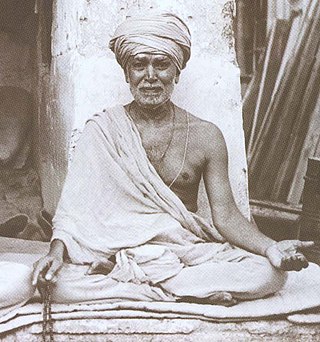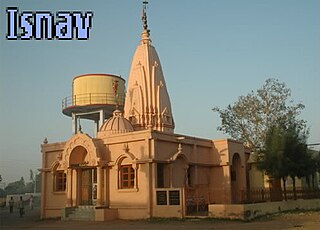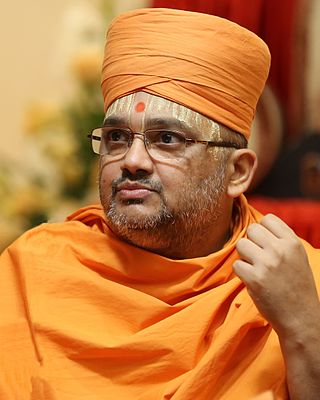
A gurukul or gurukulam is a type of education system in ancient India with shishya living near or with the guru in the same house for a period of time where they learn and get educated by their guru. Tradition by contrast, the word Guru has a very restricted use and not generally applied to individual teachers, while the institution of Gurdwara has a major social role instead of a monastic one.) The word gurukula is a combination of the Sanskrit words guru and kula. The term is also used today to refer to residential monasteries or schools operated by modern gurus. The proper plural of the term is gurukulam, though gurukuls is also used in English and some other European languages.

Bochasanwasi Akshar Purushottam Swaminarayan Sanstha is a Hindu denomination within the Swaminarayan Sampradaya. It was formed in 1905 by Yagnapurushdas following his conviction that Swaminarayan remained present on earth through a lineage of gurus starting with Gunatitanand Swami.

Pramukh Swami Maharaj was the guru and Pramukh, or president, of the Bochasanwasi Akshar Purushottam Swaminarayan Sanstha (BAPS), a major branch of the Swaminarayan Sampradaya, a Hindu denomination. BAPS regards him as the fifth spiritual successor of Swaminarayan, following Gunatitanand Swami, Bhagatji Maharaj, Shastriji Maharaj, and Yogiji Maharaj. He was believed by his followers to be in constant communion with Swaminarayan, and ontologically, the manifestation of Akshar, the eternal abode of Swaminarayan.

Amreli is a city and a municipality in Amreli district in Indian state of Gujarat.

Yogiji Maharaj, born Jina Vasani, was a Hindu swami and the fourth spiritual successor of Swaminarayan in the Bochasanwasi Akshar Purushottam Swaminarayan Sanstha (BAPS), a major branch of the Swaminarayan Sampradaya. According to the metaphysics of BAPS, Yogiji Maharaj is considered to be the next iteration of Akshar after Shastriji Maharaj in the guru parampara, an unbroken line of "perfect devotees" who provide "authentication of office through Gunatitanand Swami and back to Swaminarayan himself." Together with Pramukh Swami Maharaj, who acted as the administrative head of BAPS, he was instrumental in nurturing the growth of BAPS "through new programs, expansion into new areas, and the construction of temples". As guru, he consecrated over 60 temples and visited over 4000 towns and villages. He was particularly effective in attracting the devotion of youths and initiated a large number of them as ascetics. Furthermore, his multiple tours to Britain and East Africa were integral in the overseas expansion of BAPS. He died on 23 January 1971 after appointing Pramukh Swami Maharaj as his successor.
The Laxminarayan Dev Gadi is one of the two gadis (diocese) that together form the Swaminarayan Sampraday. It is headquartered at the Shri Swaminarayan Mandir, Vadtal and controls the Dakshin Vibhag Lekh.

Gunatitanand Swami, born Mulji Jani, was a prominent paramhansa of the Swaminarayan Sampradaya who was ordained by Swaminarayan and is accepted as the first spiritual successor of Swaminarayan by the Bochasanwasi Akshar Purushottam Swaminarayan Sanstha (BAPS). Born into a religious family in the small farming community of Bhadra in Gujarat, India, he first received religious education under his father's guru, Ramanand Swami, before encountering Swaminarayan and becoming a swami under him at the age of 25. He was revered for his spiritual discourses and divine service.

Shastriji Maharaj, born Dungar Patel and ordained Shastri Yagnapurushdas, was a swami of the Swaminarayan Sampradaya and founder of the Bochasanwasi Akshar Purushottam Swaminarayan Sanstha (BAPS). Several branches accept him as the third spiritual successor of Swaminarayan in the lineage of Aksharbrahma Gurus through whom Swaminarayan manifests, which began with Gunatitanand Swami. Born in a family of farmers in central Gujarat, India, he became a swami within the Vadtal diocese of the Swaminarayan Sampradaya at the age of 17 where he was given the name Yagnapurushdas Swami. The prefix Shastri was later added in recognition of his eminent scholarship in Sanskrit and the Hindu scriptures. He established BAPS after a doctrinal split from the Vadtal diocese of the Swaminarayan Sampradaya.
Akshar Purushottam Upasana is the BAPS-practice of worshiping Swaminarayan as a supreme being along with Gunatitanand Swami as his ideal devotee. It was formalized by Shastriji Maharaj from the teachings of Swaminarayan when he created the Bochasanwasi Shri Akshar Purushottam Swaminarayan Sanstha (BAPS) in 1907 after leaving the Swaminarayan Sampraday. It could also be referred to as Brahman Parabrahman Upasana or Bhakta Bhagwan Upasana. In this belief, Akshar and Para Brahman are worshiped together, and Para Brahman is present through the living ideal guru on Earth. Followers of BAPS regard Gunatitanand Swami as first the spiritual successor of Swaminarayan and then by Bhagatji Maharaj, Shastriji Maharaj, Yogiji Maharaj, Pramukh Swami Maharaj and Mahant Swami Maharaj..

Shri Swaminarayan Mandir, Bhuj is a Hindu temple in Bhuj. This temple was constructed by Swaminarayan, founder of the Swaminarayan Sampradaya.

The Swaminarayan Sampradaya, also known as Swaminarayan Hinduism and Swaminarayan movement, is a Hindu Vaishnava sampradaya rooted in Ramanuja's Vishishtadvaita, characterized by the worship of its charismatic founder Sahajanand Swami, better known as Swaminarayan (1781–1830), as an avatar of Krishna or as the highest manifestation of Purushottam, the supreme God. According to the tradition's lore, both the religious group and Sahajanand Swami became known as Swaminarayan after the Swaminarayan mantra, which is a compound of two Sanskrit words, swami and Narayan.

Dharmajivandasji Swami, commonly known as Shastriji Maharaj, was a Hindu saint, social worker and founder of the Shree Swaminarayan Gurukul Rajkot Sansthan. During his lifetime, he established branches of Swaminarayan Gurukul in Rajkot, Junagadh and Ahmedabad. Since he died, his followers have expanded the Shree Swaminarayan Gurukul Rajkot Sansthan all across India and around the world. Some of its main branches in India include Rajkot, Junagadh, Surat, Poicha (Nilkanthdham), Hyderabad, Taravada, and Bangalore. Its international branches include Dallas, Paramus, and Atlanta.

Isnav is a little village from one of the 22 Gam Patidar Samaj, situated at coordinates: 22°31'59"N | 72°45'51"E just nearby small town called Sojitra. Isnav is surrounded by natural countryside. The village has an entrance from the State Highway 83 in Gujarat. From the Gateway, off the highway just after 0.80 km drive is the village Isnav.

BAPS Swaminarayan Akshardham in Robbinsville, New Jersey, is a 183-acre (74.1-hectare) Hindu mandir (temple) complex that encompasses the Akshardham mandir, a traditional temple, a welcome center, museum, and event space. Following the opening of the BAPS Shri Swaminarayan Mandir in 2014, the Akshardham mandir was inaugurated on October 8, 2023 as the world’s 2nd largest Hindu temple. The temple stands 191 feet high and is situated 99 km south of New York City.

Bhadreshdas Swami is a Sanskrit scholar and an ordained monk of the Bochasanwasi Akshar Purushottam Swaminarayan Sanstha (BAPS). In 2007 he completed the Swaminarayan Bhashyam, a five-volume classical Sanskrit commentary on the Prasthanatrayi. This commentary on Hinduism's three canonical texts: the Upanishads, Bhagavad Gita, and the Brahma sutras, forms the interpretive foundation of the philosophy of Akshar Purushottam darshana, also known as Swaminarayan darshana, illuminating the Vedic roots of the Akshar Purushottama philosophy, which was propagated by the 19th-century Hindu leader, Swaminarayan and later by Shastriji Maharaj.

Mahant Swami Maharaj is the present guru and president of the Bochasanwasi Akshar Purushottam Swaminarayan Sanstha (BAPS), a major branch of the Swaminarayan Sampradaya, a Hindu denomination. BAPS regards him as the sixth spiritual successor of Swaminarayan, following Gunatitanand Swami, Bhagatji Maharaj, Shastriji Maharaj, Yogiji Maharaj, and Pramukh Swami Maharaj. He is believed by his followers to be in constant communion with Bhagwan Swaminarayan, and ontologically, the manifestation of Akshar, the perfect devotee of God.

Laljibhai Patel is an Indian diamantaire, a philanthropic social activist, and the chairman of Dharmanandan Diamonds Pvt. Ltd. (DDPL) He has been the head Dharmanandan Diamonds Group of Companies for over four and a half decades.

Akshar-Purushottam Darshan or Aksarabrahma-Parabrahma-Darsanam, "Akshar-Purushottam philosophy," is a designation used by BAPS as an alternative name for the Swaminarayan Darshana, Swaminarayan's view or teachings, to distinguish it from other Vedanta-traditions. It is based on Swaminarayan's distinction between Parabrahman and Aksharbrahman as two distinct eternal realities, which in this view sets Swaminarayan's teachings apart from other Vedanta-traditions. It is an essential element for the BAPS and it's Akṣara-Puruṣottama Upāsanā ("worship"), in which Purushottam c.q. Parabrahman is present in a lineage of Aksharbrahman guru's, who are the abode (akshar) of God.

The BAPS Swaminarayan Mandir in Edison, New Jersey is a Hindu temple built by the BAPS Swaminarayan Sanstha, a Hindu denomination within the Swaminarayan Sampradaya. The first BAPS mandir built in Edison was consecrated by Pramukh Swami Maharaj in August 1996. In 2019, a new mandir was built on the same property and a re-inauguration ceremony was conducted by senior monastic disciples.

The Nilkanth Dham is Swaminarayan Mandir a Hindu temple, and spiritual-cultural campus located in Poicha, near banks of Narmada River, in Gujarat, India. This temple is also referred to as Nilkanthdham Poicha or Poicha Swaminarayan Mandir. Nilkanthdham temple is about 80kms from Bharuch and 60kms from Vadodara by road, nearest railway station is Vadodara which is around 61.9kms away and nearest airport is Vadodara which is around 65.8kms away.

















